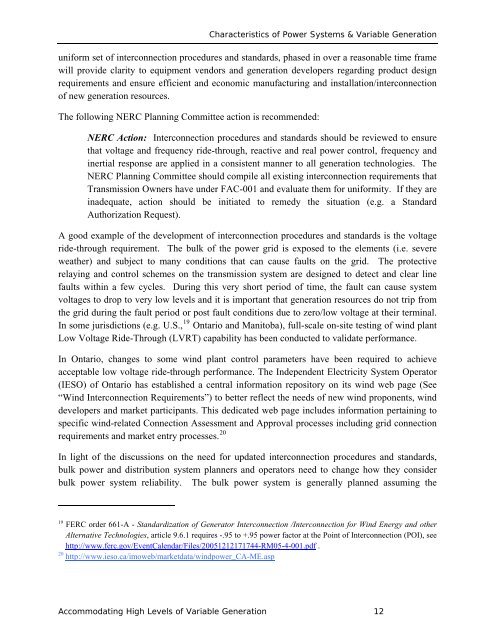Accommodating High Levels of Variable Generation - NERC
Accommodating High Levels of Variable Generation - NERC
Accommodating High Levels of Variable Generation - NERC
Create successful ePaper yourself
Turn your PDF publications into a flip-book with our unique Google optimized e-Paper software.
Characteristics <strong>of</strong> Power Systems & <strong>Variable</strong> <strong>Generation</strong><br />
uniform set <strong>of</strong> interconnection procedures and standards, phased in over a reasonable time frame<br />
will provide clarity to equipment vendors and generation developers regarding product design<br />
requirements and ensure efficient and economic manufacturing and installation/interconnection<br />
<strong>of</strong> new generation resources.<br />
The following <strong>NERC</strong> Planning Committee action is recommended:<br />
<strong>NERC</strong> Action: Interconnection procedures and standards should be reviewed to ensure<br />
that voltage and frequency ride-through, reactive and real power control, frequency and<br />
inertial response are applied in a consistent manner to all generation technologies. The<br />
<strong>NERC</strong> Planning Committee should compile all existing interconnection requirements that<br />
Transmission Owners have under FAC-001 and evaluate them for uniformity. If they are<br />
inadequate, action should be initiated to remedy the situation (e.g. a Standard<br />
Authorization Request).<br />
A good example <strong>of</strong> the development <strong>of</strong> interconnection procedures and standards is the voltage<br />
ride-through requirement. The bulk <strong>of</strong> the power grid is exposed to the elements (i.e. severe<br />
weather) and subject to many conditions that can cause faults on the grid. The protective<br />
relaying and control schemes on the transmission system are designed to detect and clear line<br />
faults within a few cycles. During this very short period <strong>of</strong> time, the fault can cause system<br />
voltages to drop to very low levels and it is important that generation resources do not trip from<br />
the grid during the fault period or post fault conditions due to zero/low voltage at their terminal.<br />
In some jurisdictions (e.g. U.S., 19 Ontario and Manitoba), full-scale on-site testing <strong>of</strong> wind plant<br />
Low Voltage Ride-Through (LVRT) capability has been conducted to validate performance.<br />
In Ontario, changes to some wind plant control parameters have been required to achieve<br />
acceptable low voltage ride-through performance. The Independent Electricity System Operator<br />
(IESO) <strong>of</strong> Ontario has established a central information repository on its wind web page (See<br />
“Wind Interconnection Requirements”) to better reflect the needs <strong>of</strong> new wind proponents, wind<br />
developers and market participants. This dedicated web page includes information pertaining to<br />
specific wind-related Connection Assessment and Approval processes including grid connection<br />
requirements and market entry processes. 20<br />
In light <strong>of</strong> the discussions on the need for updated interconnection procedures and standards,<br />
bulk power and distribution system planners and operators need to change how they consider<br />
bulk power system reliability. The bulk power system is generally planned assuming the<br />
19 FERC order 661-A - Standardization <strong>of</strong> Generator Interconnection /Interconnection for Wind Energy and other<br />
Alternative Technologies, article 9.6.1 requires -.95 to +.95 power factor at the Point <strong>of</strong> Interconnection (POI), see<br />
http://www.ferc.gov/EventCalendar/Files/20051212171744-RM05-4-001.pdf .<br />
20 http://www.ieso.ca/imoweb/marketdata/windpower_CA-ME.asp<br />
<strong>Accommodating</strong> <strong>High</strong> <strong>Levels</strong> <strong>of</strong> <strong>Variable</strong> <strong>Generation</strong> 12
















